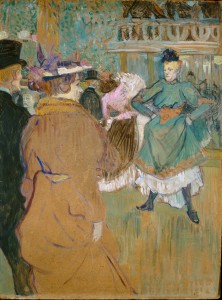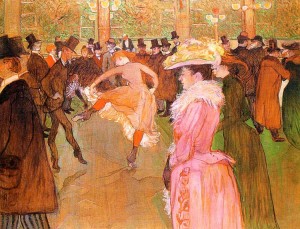Henri de Toulouse-Lautrec
Henri de Toulouse-Lautrec (1864-1901)
The French Post-Impressionism painter Henri de Toulouse-Lautrec was the archetypal bohemian artist. He was also outstanding at drawing, illustration and printmaking. A crippled aristocrat, he lingered around the cafes and brothels of Paris producing some of the most memorable images of Montmartre nightlife. Lautrec’s paintings contain a vivid collection of prostitutes, beggars, impressarios, aristocrats and drunks, whom he portrayed without criticism or disapproval. He also produced some 30 high quality advertising posters, which contributed significantly to the Belle Epoque poster craze. His works have come to symbolize both the gaiety and seediness of fin de siecle Paris. Influenced by Manet and Degas, the great figurative painters of French Impressionism, Lautrec’s key works include Woman Doing her Hair, 1891 (Musee d’Orsay) and Quadrille at the Moulin Rouge, 1892 (National Gallery of Art, Washington DC).
Born in Albi, France, Lautrec was the son and heir of Comte Alphonse-Charles de Toulouse, and the last in line of a family history that spanned over a thousand years. Traditionally the aristocracy tended to inbreed and Lautrec’s own parents were first cousins. Possibly as a result of this tradition, Lautrec suffered a number of congenital health issues. At 13 he fractured his left thighbone, which never healed properly and his legs ceased to grow any further (his height as an adult was 4 foot 9 inches). A sick and quiet boy, he immersed himself in art. As an adult, deprived of any kind of normal life as a result of his deformity, alcohol and fine art painting became his life.
Lautrec was drawn to Monmartre, an area of Paris famous for its brothels, nightlife, artists, writers and philosophers. He became such a familiar face in the brothels that he often moved in for weeks at a time. He would become the confidant and friend of both the Madame and her prostitutes, painting and sketching them at leisure. One of his favourite models, a red haired prostitute that he called Rosa La Rouge, posed for him regularly. It is alleged that he contracted syphilis though her.
Although his subjects are sometimes close to caricature, they are shown without sentiment or criticism. Among his most famous paintings from this time are depictions of the singer Yvette Guilbert and the dancer Louise Weber, also known at the La Goulue (the Glutton), who invented the ‘Can-Can’. His paintings of the dancer Jane Avril are also well known.
Some of his most notable works include: The Dance at Moulin Rouge, 1889 (Philadelphia Museum of Art); La Goulue arrives at the Moulin Rouge, 1892 (Museum of Modern Art, New York); Jane Avril, 1893 (Poster); The Model Resting, 1889 and Au Cirque: Entrée en Piste, 1899 (both at the J. Paul Getty Museum, LA); Portrait of Suzanne Valadon, 1885 (Museo Nacional de Bellas Artes, Buenos Aires) and Divan Japonaise (The Mint Museums, North Carolina).
Lautrec painted his subjects quickly, using oil paint thinned by turpentine, which allowed for rapid fine marks. He often painted on unprimed cardboard, allowing for the surface to appear, exploiting its rawness and colour. The economy of his colour and materials are as direct and basic as his subjects. He would often spend his nights drinking heavily in the bars, sketching those around him and then apply those sketches to canvas the following day.
An alcoholic most of his adult like, he died from complications induced by alcohol and syphilis, at this family estate, three short months before his 37th birthday.
Although his artistic career only lasted only 20 years, he managed to produce over 700 canvasses, 350 posters and 5,000 drawings. Copies of his posters continue to be popular today, as they were a hundred years ago. For more details concerning Henri de Toulouse-Lautrec’s place in graphic art, see: History of Poster Art.
Along with other famous painters, like Paul Cezanne, the Dutch expressionist Vincent Van Gogh and the colourist Paul Gauguin, he was one of the most innovative painters of the Post-Impressionist period. His skill lay in capturing people in their work environment. There is an immediacy and tension in his work, captured through his fast brushstroke and gaudy use of colour. His works were highly linear, and give emphasis to outlines and contours – he was able to recognizably depict many of his well-known singer subjects by their silhouette alone.
After his death, his mother and art dealer promoted his work, and contributed towards funds for a museum to be built in his hometown. Although, as was the fate of so many bohemian artists, his works did not sell well in his own time, he is now rightly considered one of the great masters of genre painting and printmaking in the history of art of the late 19th century. His works typically sell for prices in excess of $15-20 million. They hang in the collections of the best art museums across the world, and appear in most poster art catalogues.
Source:
visual-arts-cork.com




This Post Has 1 Comment